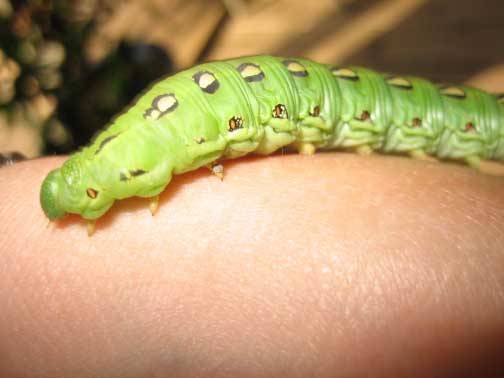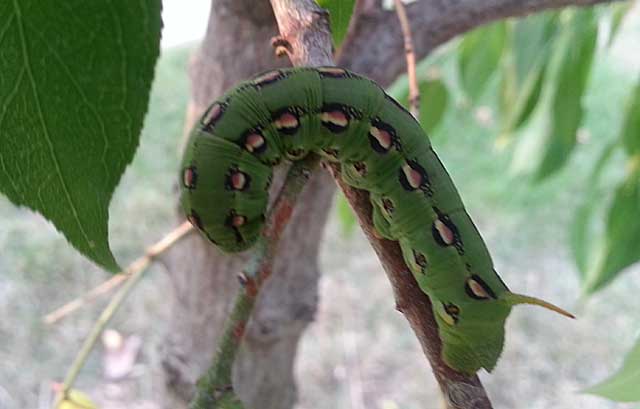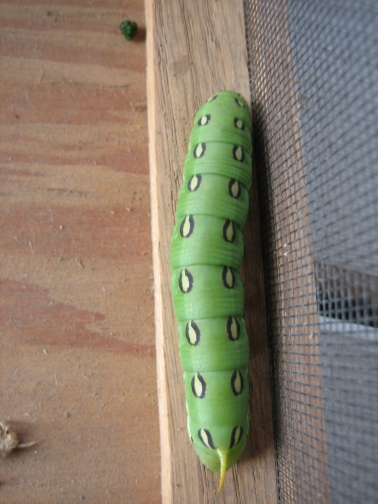Sphinginae subfamily
Sphingini tribe:
 |
Ceratomia amyntor WO, Elm Sphinx, Four-horned Sphinx:
Larvae feed on Elm (Ulmus), birch (Betula), basswood
(Tilia), cherry (Prunus).
Both green and brown forms. Four horns near
the head are diagnostic. |
 |
Ceratomia catalpae WO, Catalpa Sphinx:
This caterpillar is one of the few North American Sphingidae that feed in large groups. Colouration is distinctive. The larvae
are much more spectacular than the moths. Catalpa is the larval host.
|
 |
Ceratomia undulosa WO, Waved Sphinx:
Fraxinus, Ligustrum, Quercus, Crataegus, Chionanthus virginicus.
In the fifth instar, the spiracular ovals are decidedly red and the anal horn is off-white to pinkish laterally.
|
 |
Lapara bombycoides WO, Northern Pine Sphinx:
This caterpillar is also without the anal horn and feeds on pines.
The long stripes and reddish brown afford great camouflage.
|
 |
Lintneria eremitus WO, Hermit Sphinx:
Note triangular bump on the thorax. Beebalm (Monarda), mints (Mentha), bugleweed (Lycopis), and sage (Salvia).
|
 |
Manduca quinquemaculatus WO, Five-spotted Hawkmoth:
Tomato Hornworms. Black horn at end of abdomen. Larvae feed on potato, tobacco, tomato, and other plants in the nightshade family (Solanaceae).
|
 |
Manduca sexta WO, Carolina Sphinx:
Note the red horn and black dots anterior to the white oblique lines.
If you grow tomatoes, you have probably encountered it. maybe
|
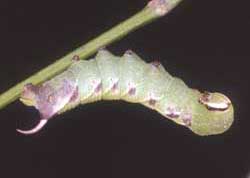
| Sphinx canadensis WO, Canadian Sphinx:
Uncommon at lights, not often reported. Larval host may be exclusively black ash (Fraxinus nigra).
Variable appearance but always with granulous (darker protrusions) on pinkish horn.
|
 |
Sphinx chersis WO, Northern Ash Sphinx, Great Ash Sphinx:
Pale bluish green. Head: pair of yellow lateral bands meeting at apex. Oblique, lateral stripes:
pale, bordered anteriorly with darker green. Ash, lilac, privet, cherry, quaking aspen.
|
 |
Sphinx drupiferarum WO, Wild Cherry Sphinx:
Hide by day, feed primarily on cherry, plum, apple
at night. Amelanchier nantuckensis
in Massachusetts, in Michigan on Prunus serotina. Note purple oblique lines.
|
 |
Sphinx kalmiae WO, Laurel Sphinx:
In final instar, black on head, lateral lines, horn and on abdominal
legs is diagnostic. Lilac and fringe.
|
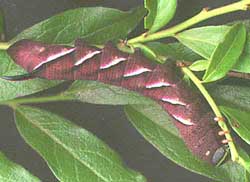 |
Sphinx poecila WO, Poecila Sphinx:
If you have blueberries, then you probably have poecila. maybe
|
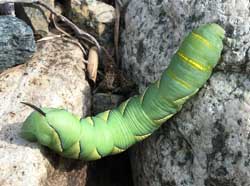 |
Sphinx vashti WO, Snowberry Sphinx:
Common snowberry (Symphoricarpos albus), coralberry (S. orbiculatus). Note two golden
lines of slightly raised bumps, one just behind head, other on thorax.
|
Smerinthini Tribe:
 |
Amorpha juglandis WO, Walnut Sphinx:
Walnut and butternut (Juglans), hickory (Carya), alder (Alnus), beech (Fagus),
hazelnut (Corylus), hop-hornbeam (Ostrya).
|
 |
Paonias excaecata WO, Blinded Sphinx:
Willows, birches, cherries. I have also found them in the wild on oak in eastern Canada.
|
 |
Paonias myops WO, Small-eyed Sphinx:
Wild cherry species are favorites, but eggs
will also be deposited on birches, other forest trees.
Varying degrees in amount of red markings along sides.
|
 |
Smerinthus cerisyi WO, Cerisy's Sphinx;
Pale green, with granular skin, pale lateral diagonal lines, faint red spiracular circles, very pale longitudinal lines running from
head to more pronounced anal diagonal line. Green heads bounded dorsally with pale yellow inverted V.
|
 |
Smerinthus jamaicensis WO, Twin-spotted Sphinx:
Birches and cherries, but are expecially fond of poplars and willows. Red markings on sides vary greatly from specimen to specimen.
|
Macroglossinae subfamily
Dilophonotini tribe:
 |
Hemaris diffinis WO, Snowberry Clearwing:
Snowberry (Symphoricarpos), honeysuckle (Lonicera), Coralberry, viburnums, Blue Dogbane
(Apocynum), dwarf bush honeysuckle (Diervilla lonicera). Horn black, yellow base.
|
 |
Hemaris thysbe WO, Hummingbird Clearwing:
Orangey-pink prepupal form. Lateral line runs from S1 to blue horn.
Viburnum and related plants.
|
Philampelini Tribe:
 |
Eumorpha achemon WO, Achemon Sphinx:
Grape (Vitis), Virginia Creeper (Parthenocissus quinquefolia), other vines, ivies (Ampelopsis).
Both light (green) form and darker (tan/brown) form. Note six "segmented" oblique lines.
|
 |
Eumorpha pandorus WO, Pandorus Sphinx:
If you have Grape or Virginia Creeper nearby, then you might encounter
this species. Note five large white ovals. Orangey-brown and green
forms also.
|
Macroglossini tribe:
 |
Amphion floridensis WO, Nessus Sphinix:
Virginia creeper, Grape (Vitis), ampelopsis (Ampelopsis), cayenne pepper (Capsicum).
Larvae are green until the final instar.
|
 |
Darapsa choerilus WO, Azalea Sphinx:
Azalea, Viburnum; progress very rapidly. Larva, left, on Viburnum cassinoides readying to
pupate. Color change from green to light burgundy-brown indicates imminent pupation.
|
 |
Darapsa myron WO, Virginia Creeper Sphinx, Grapevine Sphinx:
If you have foodplants indicated in common names, you probably have myron. Virginia creeper (Parthenocissus quinquefolia),
Grape (Vitis), Ampelopsis, Viburnum.
|
 |
Deidamia inscriptum WO, Lettered Sphinx:
Grape (Vitis), ampelopsis (Ampelopsis), Virginia creeper (Parthenocissus).
The alternating yellow and greyish-green rings across the back distinguish this larva.
|
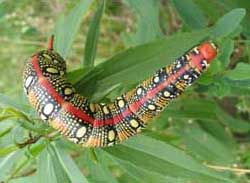 |
Hyles euphorbiae WO, Leafy Spurge Hawk Moth:
Leafy spurge. Brightly colored, with pronounced "horn" near rear end.
Young variously patterned with green, yellow, black; older larvae: distinctive red, black, yellow, white color
pattern. Larvae approach 10 cm; when disturbed, regurgitate slimy green liquid.
|
 |
Hyles gallii WO, Bedstraw Hawk Moth, Gallium Sphinx:
Larvae come in black and in brown forms and often feed on Epilobium (fireweed).
|
 |
Hyles lineata SN/EC/JT, White-lined Sphinx:
Variable; Willow weed (Epilobium), four o'clock (Mirabilis),
apple (Malus), evening primrose (Oenothera), elm
(Ulmus), grape (Vitis), tomato (Lycopersicon),
purslane (Portulaca), Fuschia. Red/black swellings split by dorso-lateral lines.
|
Hyles lineata, Rochester, August 27, 2008, Sue Nevling and son
Hyles lineata, Stewartville, June 29, 2012, Emily Carson
Hyles lineata, Rochester, September 27, 2013, Jeff Tostenson
 |
Sphecodina abbottii WO, Abbott's Sphinx:
Feed at night, grape (Vitis), ampelopsis (Ampelopsis); hide on bark by day. Virginia creeper. Also dark form
without green patches. Note "raised eye", replacing anal horn.
|
|
|
